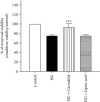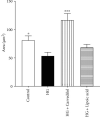The Neuroprotective Effect of Carvedilol on Diabetic Neuropathy: An In Vitro Study
- PMID: 33532503
- PMCID: PMC7834839
- DOI: 10.1155/2021/6927025
The Neuroprotective Effect of Carvedilol on Diabetic Neuropathy: An In Vitro Study
Abstract
Diabetic neuropathy serves as a major complication for diabetic patients across the world. The use of effective treatment is integral for reducing the health complications for diabetic patients. This study has evaluated the carvedilol potential neuroprotective effect on diabetic neuropathy. An in vitro model of diabetic neuropathy was used, including dorsal root ganglia (DRG) that were cultured from male adult mice C57BL. These were incubated for about twenty-four hours in high glucose (HG) media (45 mM). Some cells were incubated with carvedilol (10 μM). Neuronal viability, neuronal morphology, and activating transcription factor 3 (AFT3) were measured. The cell viability was decreased, along with neuronal length, soma area, and soma perimeter with HG media. Also, there was an overexpression of ATF3, which is a neuronal stress response marker. The pretreatment with carvedilol increased the viability of DRG as compared to HG-treated cells. Also, it significantly protected the DRG from HG-induced morphology changes. Though it shows a decrease in AFT3 expression, the statistical results were insignificant. The current study demonstrates the neuroprotective effect of carvedilol against HG-induced DN using an in vitro model. This could be through carvedilol antioxidant effects.
Copyright © 2021 Rania M. Magadmi et al.
Conflict of interest statement
The author declares that there is no conflict of interest regarding the publication of this paper.
Figures








Similar articles
-
Anti-oxidative and anti-inflammatory effects of cinnamaldehyde on protecting high glucose-induced damage in cultured dorsal root ganglion neurons of rats.Chin J Integr Med. 2016 Jan;22(1):19-27. doi: 10.1007/s11655-015-2103-8. Epub 2015 Nov 17. Chin J Integr Med. 2016. PMID: 26577110
-
Therapeutic potential of VEGF and VEGF-derived peptide in peripheral neuropathies.Neuroscience. 2013 Aug 6;244:77-89. doi: 10.1016/j.neuroscience.2013.03.050. Epub 2013 Apr 11. Neuroscience. 2013. PMID: 23583762
-
SOD2 protects neurons from injury in cell culture and animal models of diabetic neuropathy.Exp Neurol. 2007 Dec;208(2):216-27. doi: 10.1016/j.expneurol.2007.07.017. Epub 2007 Aug 3. Exp Neurol. 2007. PMID: 17927981 Free PMC article.
-
Deciphering the Neuroprotective Role of Glucagon-like Peptide-1 Agonists in Diabetic Neuropathy: Current Perspective and Future Directions.Curr Protein Pept Sci. 2021;22(1):4-18. doi: 10.2174/1389203721999201208195901. Curr Protein Pept Sci. 2021. PMID: 33292149 Review.
-
Pathogenesis of diabetic neuropathy: bad to the bone.Ann N Y Acad Sci. 2011 Dec;1240:70-6. doi: 10.1111/j.1749-6632.2011.06309.x. Ann N Y Acad Sci. 2011. PMID: 22172042 Free PMC article. Review.
Cited by
-
Gi-protein-coupled β 1-adrenergic receptor: re-understanding the selectivity of β 1-adrenergic receptor to G protein.Acta Biochim Biophys Sin (Shanghai). 2022 Aug 25;54(8):1043-1048. doi: 10.3724/abbs.2022096. Acta Biochim Biophys Sin (Shanghai). 2022. PMID: 35959878 Free PMC article. Review.
-
Neuroprotective Effect of Red Sea Marine Sponge Xestospongia testudinaria Extract Using In Vitro and In Vivo Diabetic Peripheral Neuropathy Models.Pharmaceuticals (Basel). 2022 Oct 24;15(11):1309. doi: 10.3390/ph15111309. Pharmaceuticals (Basel). 2022. PMID: 36355482 Free PMC article.
-
Current advancement in the preclinical models used for the assessment of diabetic neuropathy.Naunyn Schmiedebergs Arch Pharmacol. 2024 May;397(5):2727-2745. doi: 10.1007/s00210-023-02802-0. Epub 2023 Nov 21. Naunyn Schmiedebergs Arch Pharmacol. 2024. PMID: 37987794 Review.
-
The therapeutic potential of (R)-carvedilol in Huntington's disease through enhancement of autophagy-lysosomal pathway via GSK-3β inhibition.Neurotherapeutics. 2025 Apr;22(3):e00557. doi: 10.1016/j.neurot.2025.e00557. Epub 2025 Feb 25. Neurotherapeutics. 2025. PMID: 40011132 Free PMC article.
-
Effects of Carvedilol on Blood Pressure, Blood Sugar, and Blood Lipids in Elderly Patients with Refractory Hypertension.Comput Math Methods Med. 2022 Jul 27;2022:7889024. doi: 10.1155/2022/7889024. eCollection 2022. Comput Math Methods Med. 2022. Retraction in: Comput Math Methods Med. 2023 Sep 27;2023:9867142. doi: 10.1155/2023/9867142. PMID: 35936366 Free PMC article. Retracted.
References
-
- Shatnawi N. J., Al-Zoubi N. A., Hawamdeh H. M., Khader Y. S., Gharaibeh K., Heis H. A. Predictors of major lower limb amputation in type 2 diabetic patients referred for hospital care with diabetic foot syndrome. Diabetes, metabolic syndrome and obesity : targets and therapy. 2018;11:313–319. doi: 10.2147/DMSO.S165967. - DOI - PMC - PubMed
MeSH terms
Substances
LinkOut - more resources
Full Text Sources
Other Literature Sources
Medical
Miscellaneous

